Kawasaki Vulcan 1600 Mean Streak (2003-2008) Maintenance Schedule and Service Intervals
This is the maintenance schedule with associated service intervals for the Kawasaki Vulcan 1600 Mean made between 2003 and 2008 — the VN1600 Mean Streak. We previously had this grouped together with the Vulcan 1600 Classic and Nomad, but the parts are slightly different.
The Vulcan is Kawasaki’s name for their cruiser, tourer, and bagger range. The Vulcan 1600 is an update to the Vulcan 1500 FI. While the 1500 engine came in both carburettor-fed and fuel injected forms, the 1600 is all fuel injected.
The Kawasaki Vulcan 1600 Mean Streak is powered by a 1,552 cc (barely rounds up to 1600!) liquid-cooled SOHC fuel-injected V-twin engine with two spark plugs per cylinder. It has a five-speed transmission and shaft drive.
Here are the differences between the motorcycles in the range:
- Kawasaki Vulcan 1600 Classic (2001-2008): The baseline, classic cruiser. The 1600 Classic was replaced by the 1700 Classic in 2009.
- Kawasaki Vulcan 1600 Nomad (2005-2008): The version with the touring windscreen and luggage. The engine is otherwise identical, so the maintenance schedule is kept in the same page.
- Kawasaki Vulcan 1600 Mean Streak (2003-2008): Tuned for about 3kW/5hp more power (with different cam profiles and fuelling), with more aggressive rake, inverted forks, and different tyres, for sportier handling. The ride is quite different.
The Mean Streak has some different part numbers, so I’m keeping the maintenance schedule separate (here).
This site has links for things like oil and spark plugs from which we earn a commission (which unfortunately nobody can save, not even us). If you appreciate this work, then please use those links. Thanks!
Kawasaki Vulcan 1600 Mean Streak Service Intervals
Having shaft drives, fuel injection, and maintaining a 1600 Mean Streak is a lot easier than the previous model used to be!
The basic service interval for the Kawasaki Vulcan 1600 Mean Streak is every 3750 miles / 6000 km between services, but only 7500 miles or 12000 km between oil changes.
Because the Mean Streak has hydraulic valve lash adjusters, you don’t need to adjust the valve clearances.
While the shaft drive is low maintenance, you do need to replace your shaft drive with new gear oil 24000 miles / 36000 km. Many owners don’t, though some owners do it obsessively with every oil change.
What you need to service your Kawasaki Vulcan 1600 Mean Streak
Even though it’s a shaft-driven bike, you still have to do regular service on your Vulcan 1600 Mean Streak.
Top priority is keeping the fluids changed — coolant, brake/clutch fluid, and gear oil (occasionally).
But thankfully, there’s no chain to maintain!
Here are the general consumables you’ll need to maintain your Kawasaki Vulcan 1600 Mean Streak.
| Part | Kawasaki Vulcan 1600 Spec |
|---|---|
| Oil | You need SAE 10W-40 engine oil with API SH or SJ (or newer, e.g., SL or SM) with JASO MA rating, for example Kawasaki 10W-40 Engine Oil, or another high-grade oil like Motul 7100. Some owners (e.g. this thread) like Shell Rotella T6. Don’t over-torque the drain bolt (spec is 30 Nm/22 lb-ft per the manual) — use a torque wrench if you don’t have experience with how much torque is enough. |
| Oil filter | Use a Hiflofiltro filter for easy replacement, part HF204RC. Torque for oil filter is 18 Nm (13 ft-lb) (use a torque wrench, and it’s easier on the K&N one) |
| Final drive oil | Remember to change this periodically. It’s not hard! Use Mobil 1 Gear Oil, a popular choice. |
| Brake pads | Many riders upgrade to EBC HH brake pads (see this thread). See the table below for the correct part numbers to get. |
| Spark plugs | NGK DPR6EA-9, with a spark plug gap of 0.8-0.9mm (use a spark plug gapping tool), torqued to 18 Nm or 13 ft-lb (use a torque wrench). Remember you need four spark plugs as it’s a twin spark engine. (DPR6EA-9 4-pack)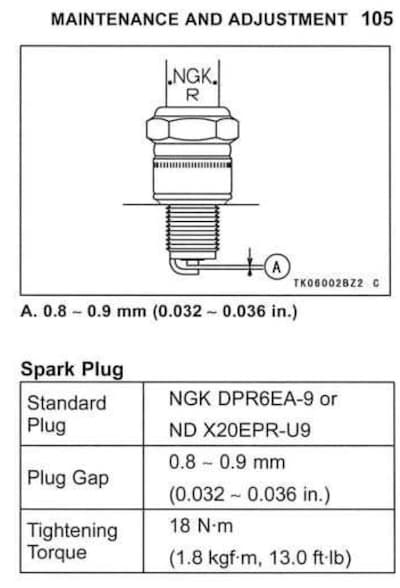 |
| Air filter | Most people replace the OEM air filter with a K&N aftermarket air filter (functionally identical). You can use the K&N part number KA-1596 for the Mean Streak. |
| Brake/Clutch fluid | Spec is to use DOT 4 brake/clutch fluid, e.g. Castrol DOT 4. |
| Coolant | Use, as ships with the Vulcan, 50/50 pre-mix of ethylene glycol-based coolant with anti-corrosion inhibitors, e.g. Valvoline Zerex G05 |
| Grease | Use a lithium soap-based grease for all the important greasing points. |
Brake pads for Kawasaki Vulcan 1600 Meak Streak
Which brake pads you get depends on which year of Mean Streak you have. Parts below are for EBC brake pads, a common and affordable (and easier to get than OEM) upgrade.
| Vulcan 1600 model | Front | Rear |
|---|---|---|
| 2004 Mean Streak | FA188HH | FA231HH |
| 2005-2008 Mean Streak | FA369/4HH | FA231HH |
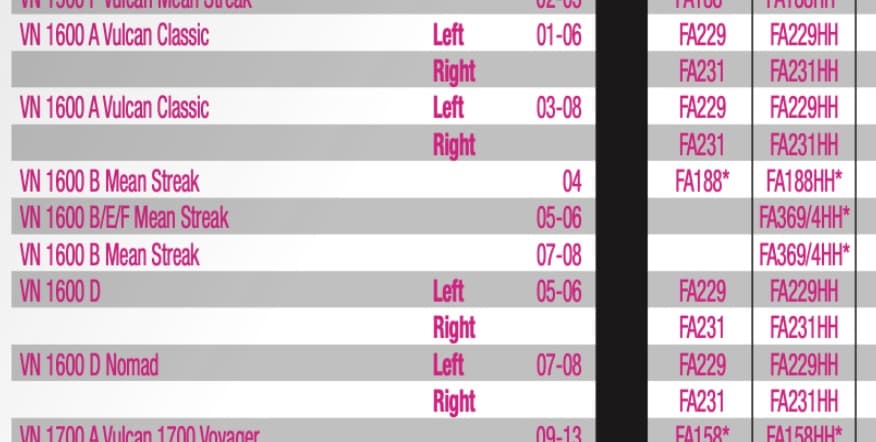
Maintenance Schedule for Kawasaki Vulcan 1600 Mean Streak motorcycles
Below is the maintenance schedule for the Kawasaki Vulcan 1600 Mean Streak. It’s taken straight from the manual for them and adapted to fit a website, plus made more legible.
The following is the list of maintenance operations and to be done on this motorcycle with a time or distance interval — whichever comes earlier.
Notes/Legend:
- For higher odometer readings, repeat at the frequency interval established here
- Kawasaki recommends items related to brakes, clutch, coolant, and steering be serviced by a dealer or mechanic.
- Items marked “Check”: also adjust, torque, or replace as necessary.
- The break-in service is omitted.
| km x 1000 | 6 | 12 | 18 | 24 | 30 | 36 | |
|---|---|---|---|---|---|---|---|
| mi x 1000 | 4 | 7.5 | 12 | 15 | 20 | 24 | Every |
| Engine oil — change (Kawasaki 10W-40 Engine Oil or Motul 7100) | ✓ | ✓ | ✓ | Year | |||
| Oil filter — replace (HF204RC) | ✓ | ✓ | ✓ | ||||
| Spark plug — clean and gap (replace with DPR6EA-9 if necessary) | ✓ | ✓ | ✓ | ✓ | ✓ | ✓ | |
| Air cleaner element —clean (replace with KA-1596 if necessary) | ✓ | ✓ | ✓ | ||||
| Brake/clutch fluid — change (use Castrol DOT 4) | ✓ | 2 years | |||||
| Idle speed — check | ✓ | ✓ | ✓ | ||||
| Throttle control system — check | ✓ | ✓ | ✓ | ✓ | ✓ | ✓ | |
| Air suction valve — check | ✓ | ✓ | ✓ | ✓ | ✓ | ✓ | |
| Evaporative emission control system (CA only) — check | ✓ | ✓ | ✓ | ✓ | ✓ | ✓ | |
| Brake/clutch hoses, connections — check | ✓ | ✓ | ✓ | ✓ | ✓ | ✓ | |
| Brake light switch — check | ✓ | ✓ | ✓ | ✓ | ✓ | ✓ | |
| Brake pad wear — check# | ✓ | ✓ | ✓ | ✓ | ✓ | ✓ | |
| Brake/clutch fluid level — check | ✓ | ✓ | ✓ | ✓ | ✓ | ✓ | Month |
| Fuel hose, connections — check | ✓ | ✓ | ✓ | ✓ | ✓ | ✓ | |
| Steering — check | ✓ | ✓ | ✓ | ✓ | ✓ | ✓ | |
| Final gear case oil level — check | ✓ | ✓ | ✓ | ||||
| Final gear case oil — change (use Mobil 1 Gear Oil) | ✓ | ||||||
| Propeller shaft joint – lubricate | ✓ | ✓ | |||||
| Nut, bolt, fastener tightness — check | ✓ | ✓ | ✓ | ||||
| Tire wear — check | ✓ | ✓ | ✓ | ✓ | ✓ | ✓ | |
| General lubrication — perform (lithium soap-based grease) | ✓ | ✓ | ✓ | ||||
| Front fork oil leak — check | ✓ | ✓ | ✓ | ||||
| Rear shock absorber oil leak — check | ✓ | ✓ | ✓ | ||||
| Swingarm pivot – lubricate | ✓ | ✓ | |||||
| Coolant — change (Valvoline Zerex G05) | ✓ | 2 years | |||||
| Radiator hoses, connections — check | |||||||
| Steering stem bearing — lubricate | ✓ | 2 years | |||||
| Brake/clutch master cylinder cup and dust seal — replace | 4 years | ||||||
| Caliper piston seal and dust seal — replace | 4 years | ||||||
| Clutch slave cylinder piston seal — replace | 4 years |
Tyre size and tyre pressure for the Kawasaki Vulcan 1600 Mean Streak
The Kawasaki Vulcan 1600 Mean Streak has the following tyres and tyre sizes standard (tubeless type).
| Wheel | Size | Brand(s) | Pressure |
|---|---|---|---|
| Front | 130/70 R17 M/C 62H | * BRIDGESTONE “BATTLAX BT020F RADIAL * DUNLOP “D220F STG” | 250 kPa/36 psi |
| Rear | 170/60 R17 M/C 72H | BRIDGESTONE “BATTLAX BT020R RADIAL” DUNLOP “D220 STG” | 250 kPa/36 psi |
Of course, you can use whatever tyres are commonly available (the Meanie is getting a little long in the tooth and tyre technology changes).
Note that the Mean Streak has slightly different tyre profiles to the standard Vulcan 1600 — don’t get them mixed up!
About the Kawasaki Vulcan 1600 Mean Streak
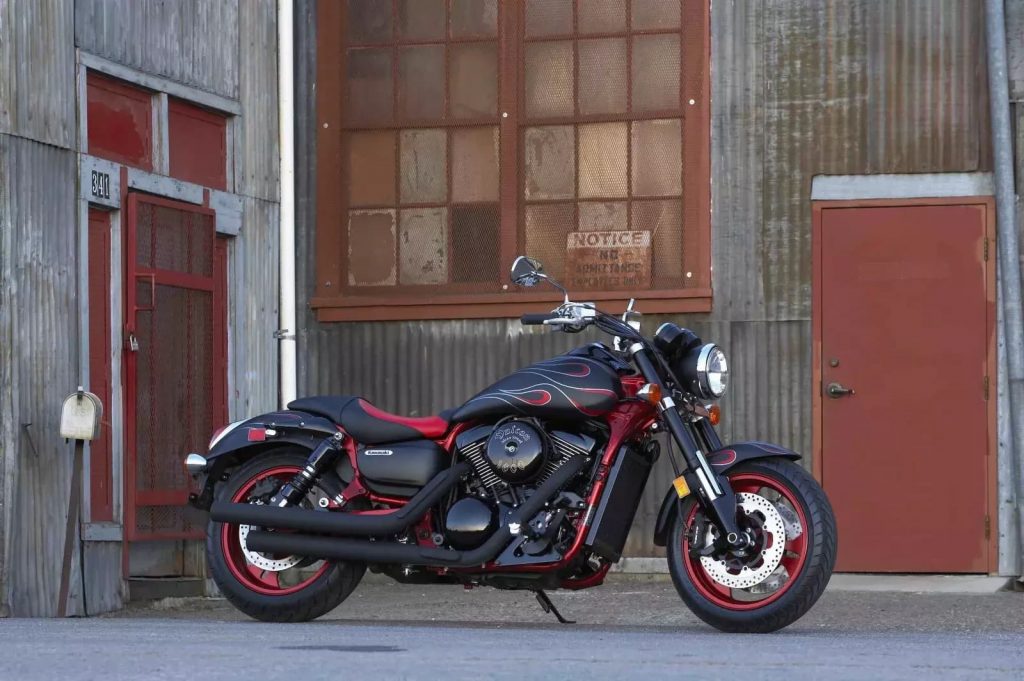
The Mean Streak is the “muscle cruiser” of the Kawasaki Vulcan 1600 line. It uses the same base engine, but with hotter tuning, as well as more aggressive handling characteristics. And it looks great!
The Kawasaki Vulcan 1600 Mean Streak is based heavily on the rest of the Vulcan 1600 line, but the motor is tuned for slightly more power, and the entire motorcycle has a more aggressive posture.
In the world of cruisers, 1600 is a “mid-displacement” motorcycle, somewhere below the ~1800-cc range of the big ones, and especially below the capacity of the Vulcan 2000, one of the biggest cruisers ever made.
The 95 c.i. motor has an oversquare piston, with a 102 x 95 mm bore and stroke, which helps it rev nicely — the Mean Streak makes its peak power of 53 kW (72 hp) at 5300 rpm, relatively high for a large displacement cruiser. Torque comes on nice and low though, with a peak of 127 Nm / 94 lb-ft at 2800 rpm.
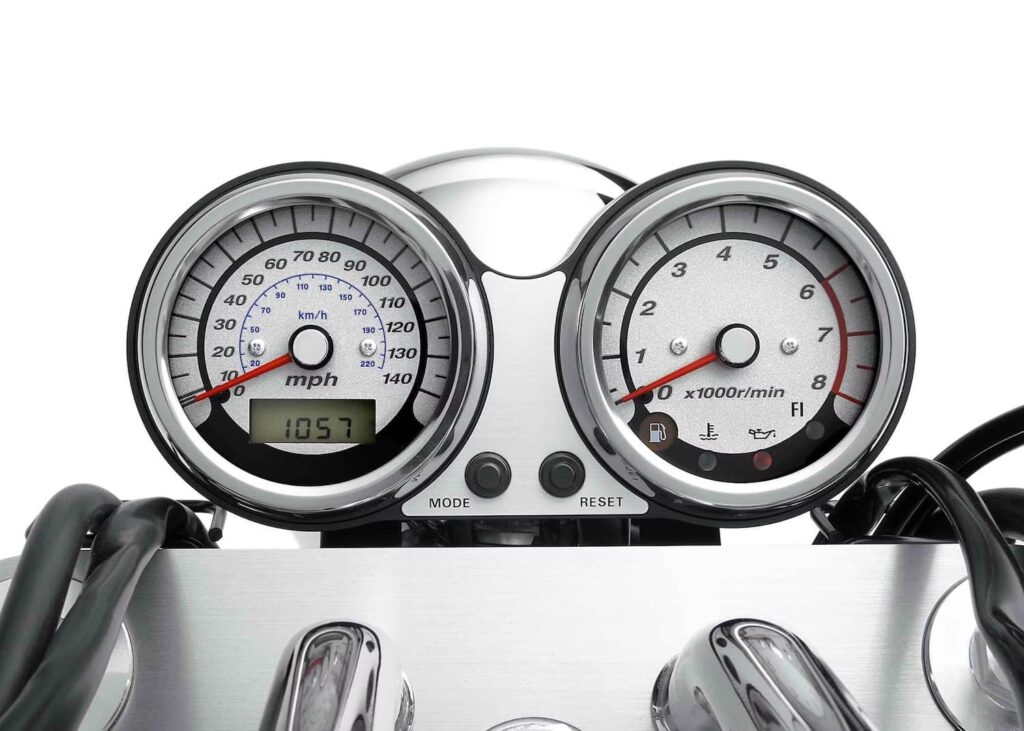
The final drive is via a 5-speed transmission and, interestingly for a cruiser, a shaft drive. Even more maintenance-free than a belt!
The Mean Streak, like other Vulcan 1600s, has a fairly advanced engine with single overhead cam and four valves per cylinder. It has modern elements like fuel injection and liquid cooling. But it kept a bit of old school with hydraulic valve lash adjusters, which is why there’s no valve service requirement specified in the manual. Hooray!
The ride gear is surprisingly sporty, with twin 320mm discs and four-piston calipers pulling it up. The fork is a 43mm inverted unit, and the rear suspension is comprised of twin shocks adjustable for air pressure and rebound damping.
Reference Screenshot from the Manual for the Kawasaki Vulcan 1600 Mean Streak
The above maintenance schedule comes directly from the user’s manual for the 2003-2008 Kawasaki Vulcan 1600 Mean Streak. We checked various years to make sure the maintenance schedule remained the same.
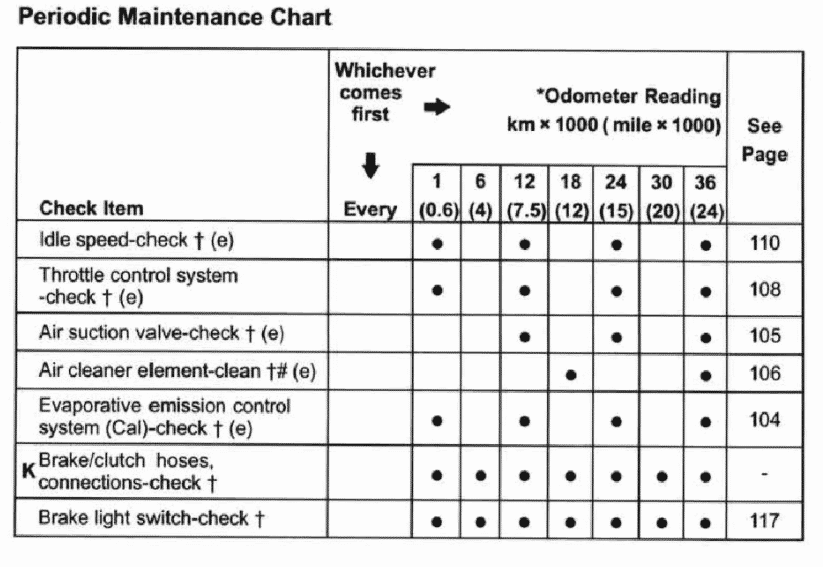
You can access the manual for the Mean Streak from Kawasaki’s website here.
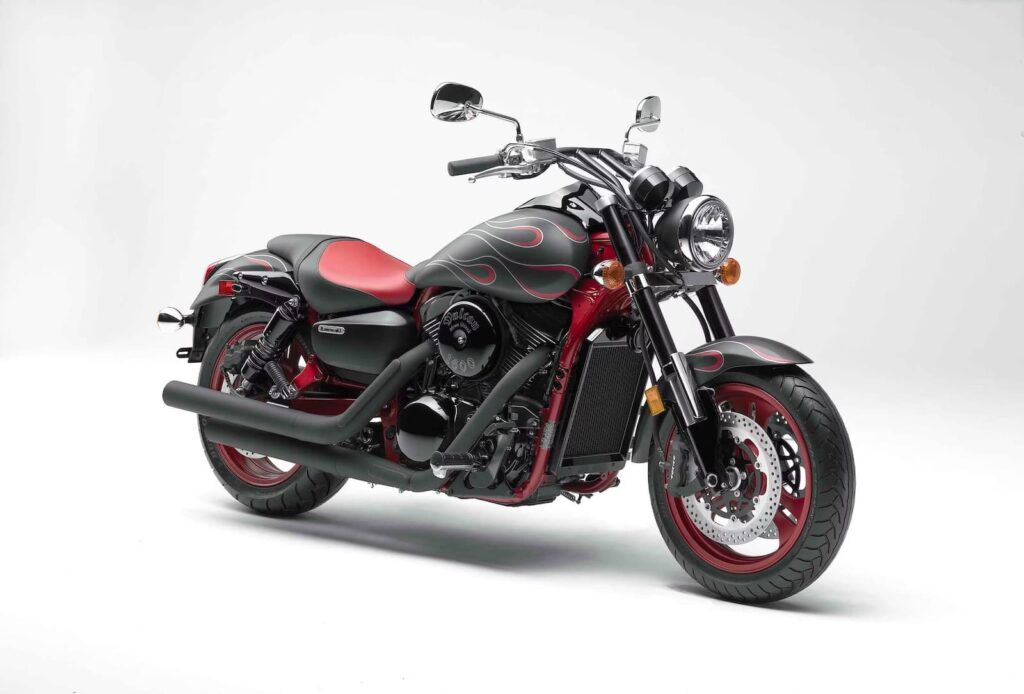
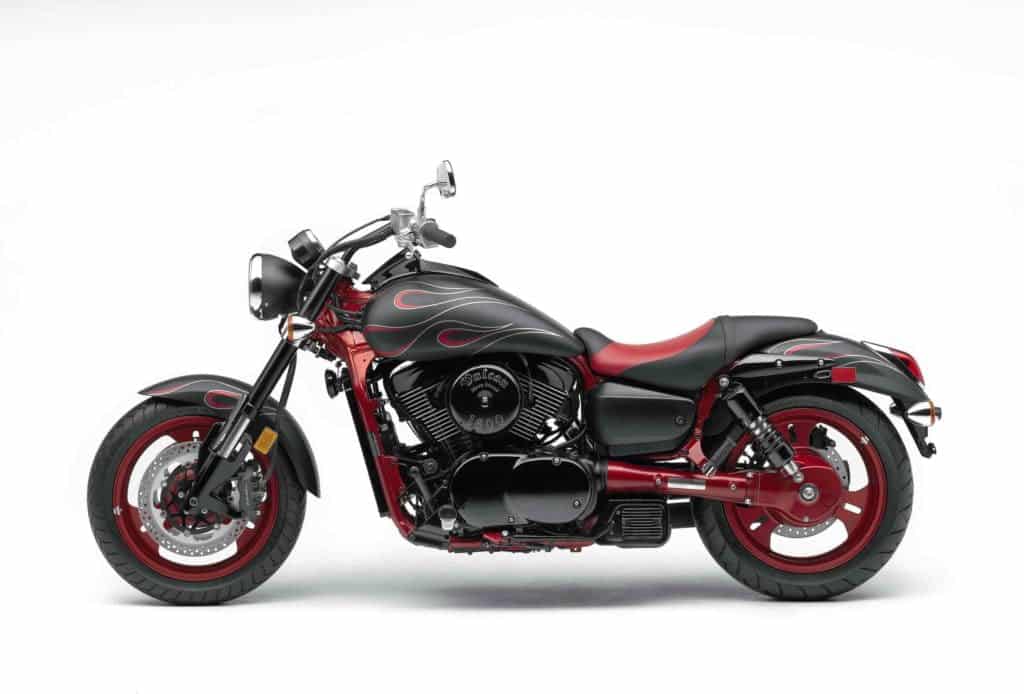
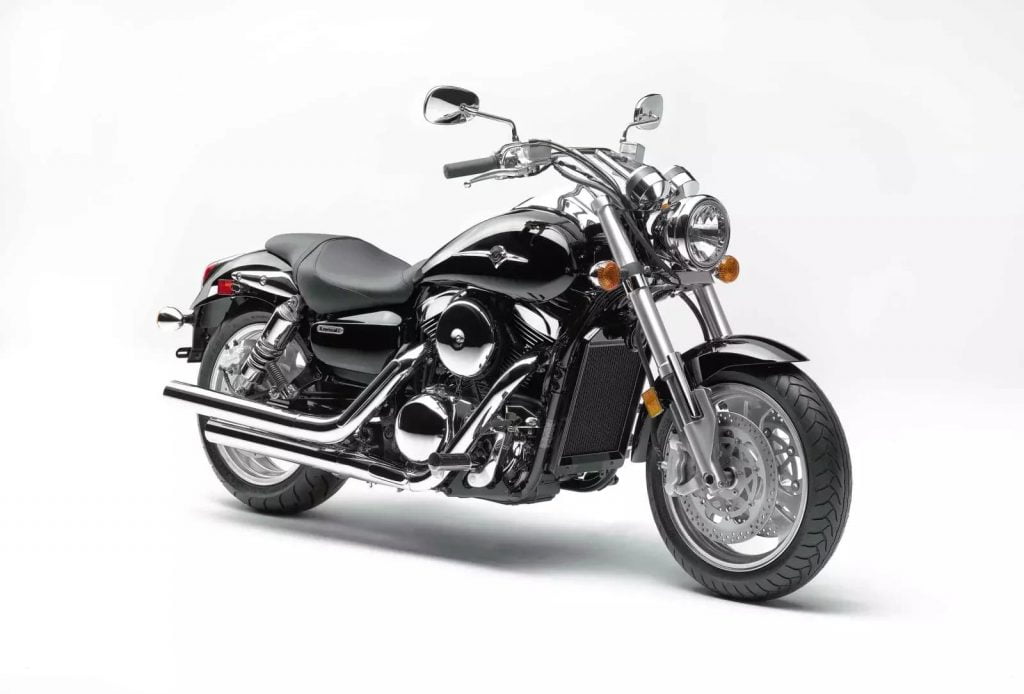
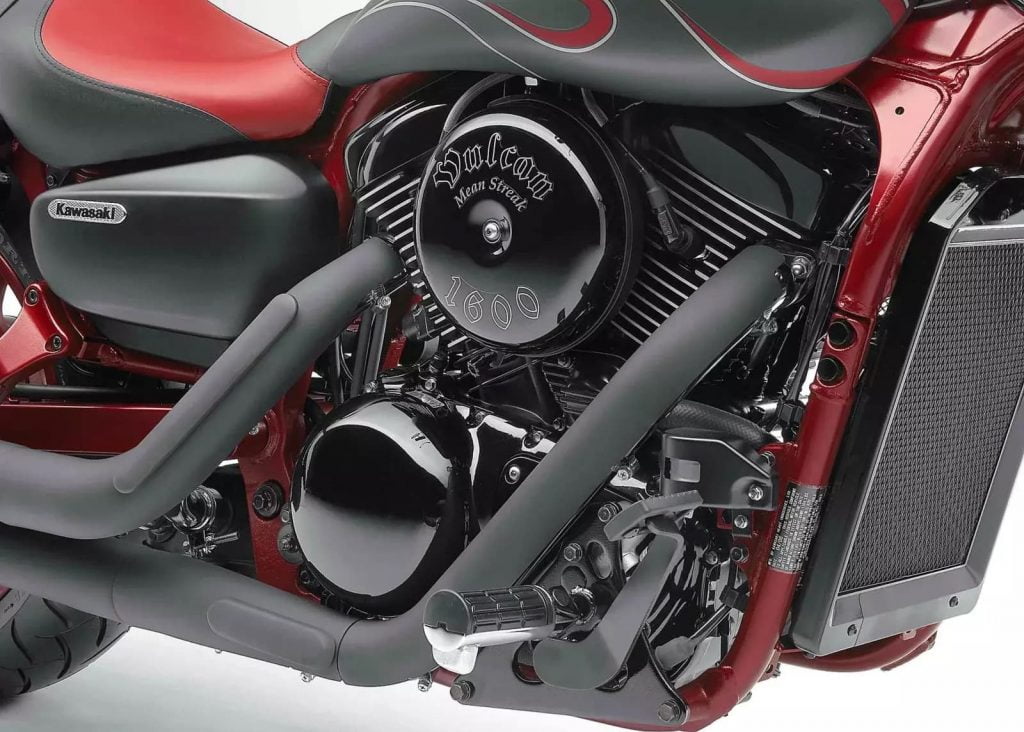
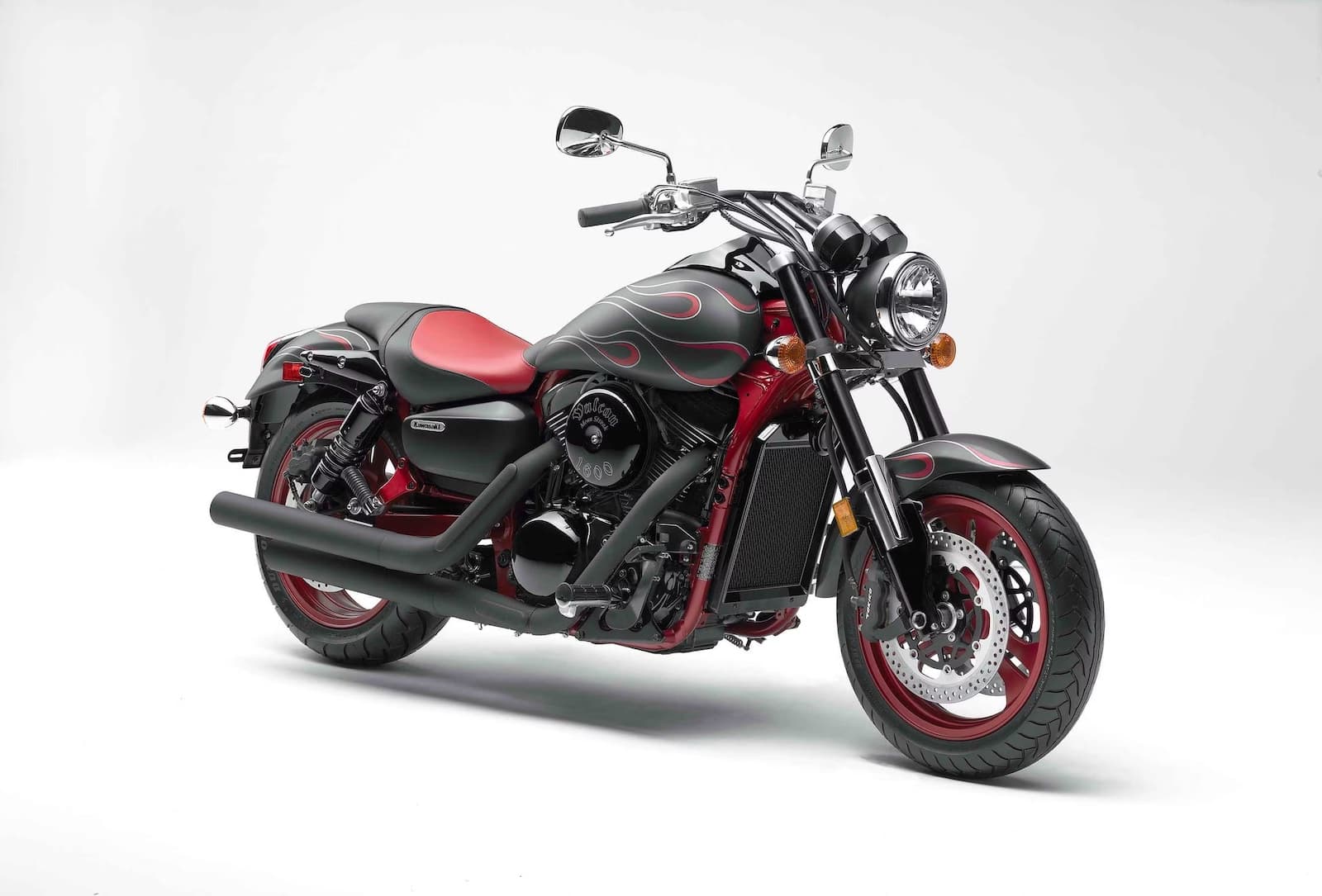
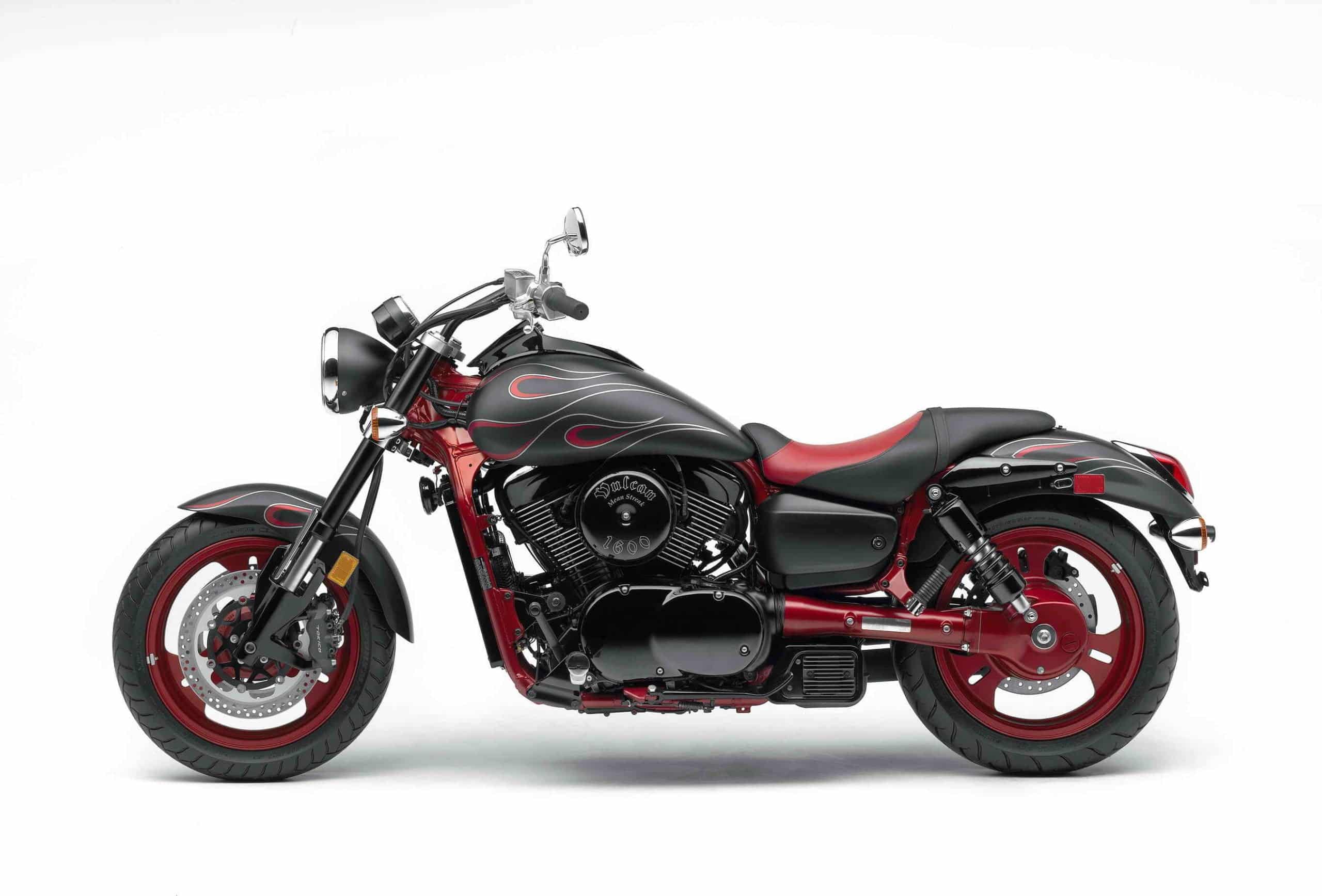
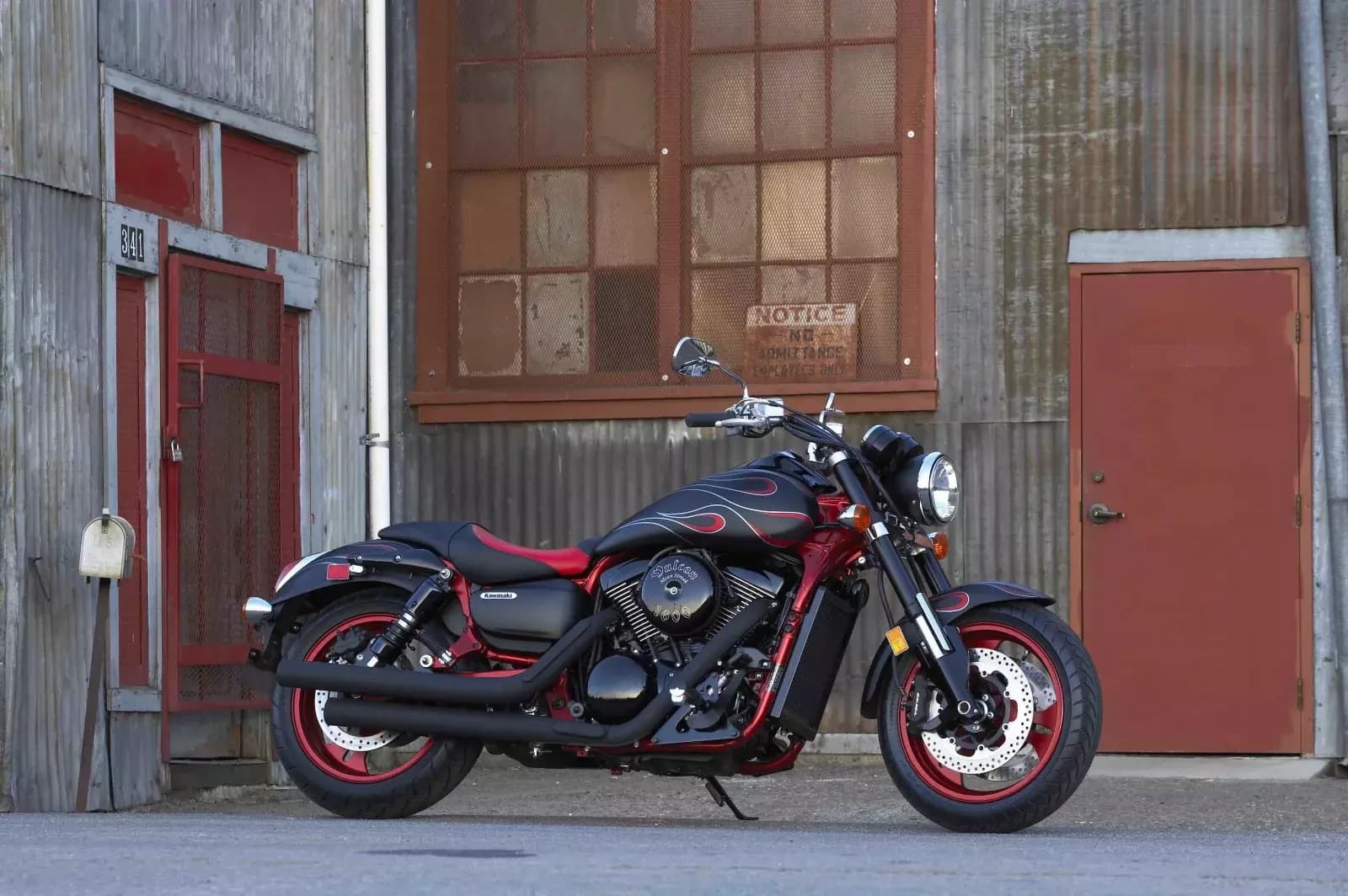
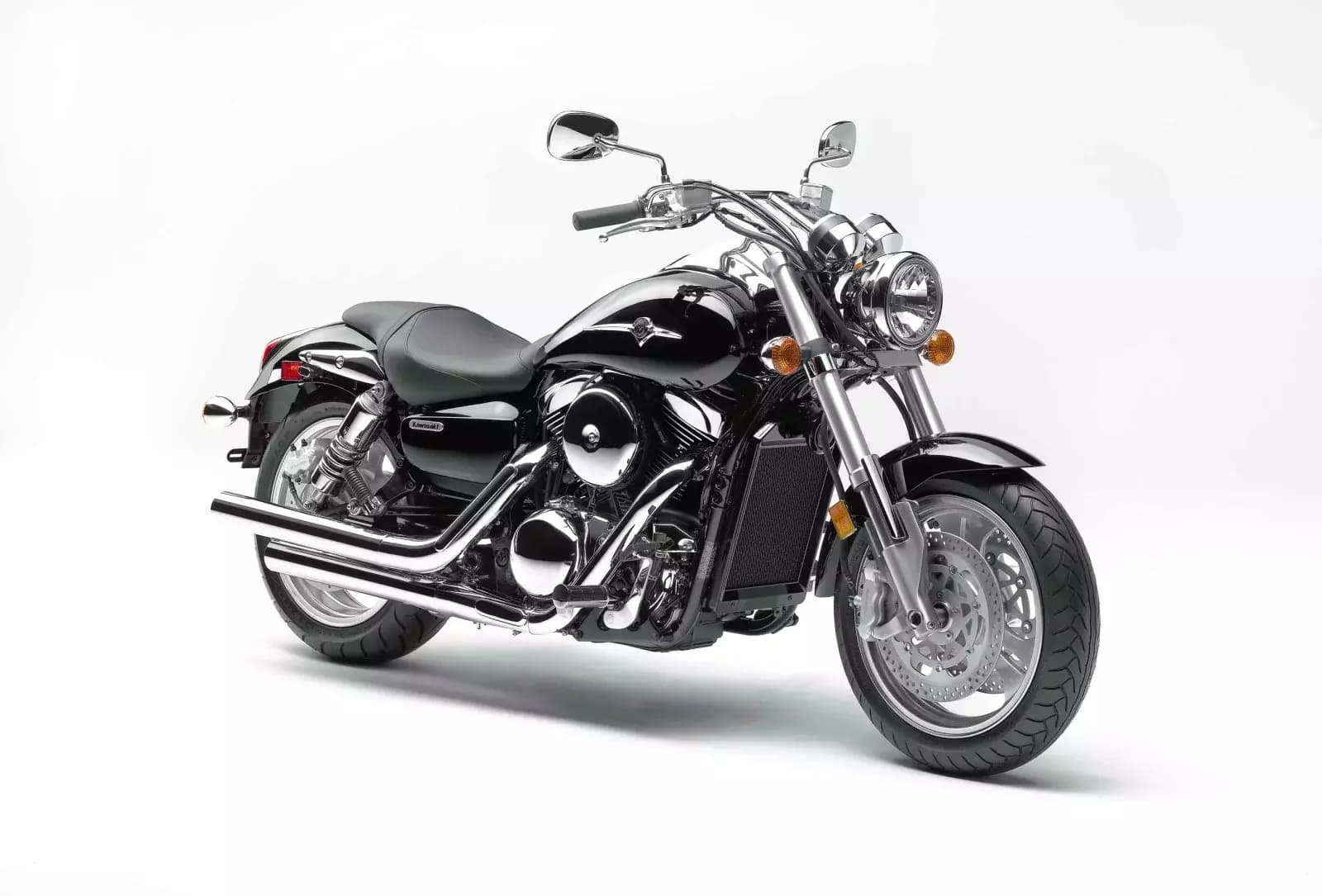
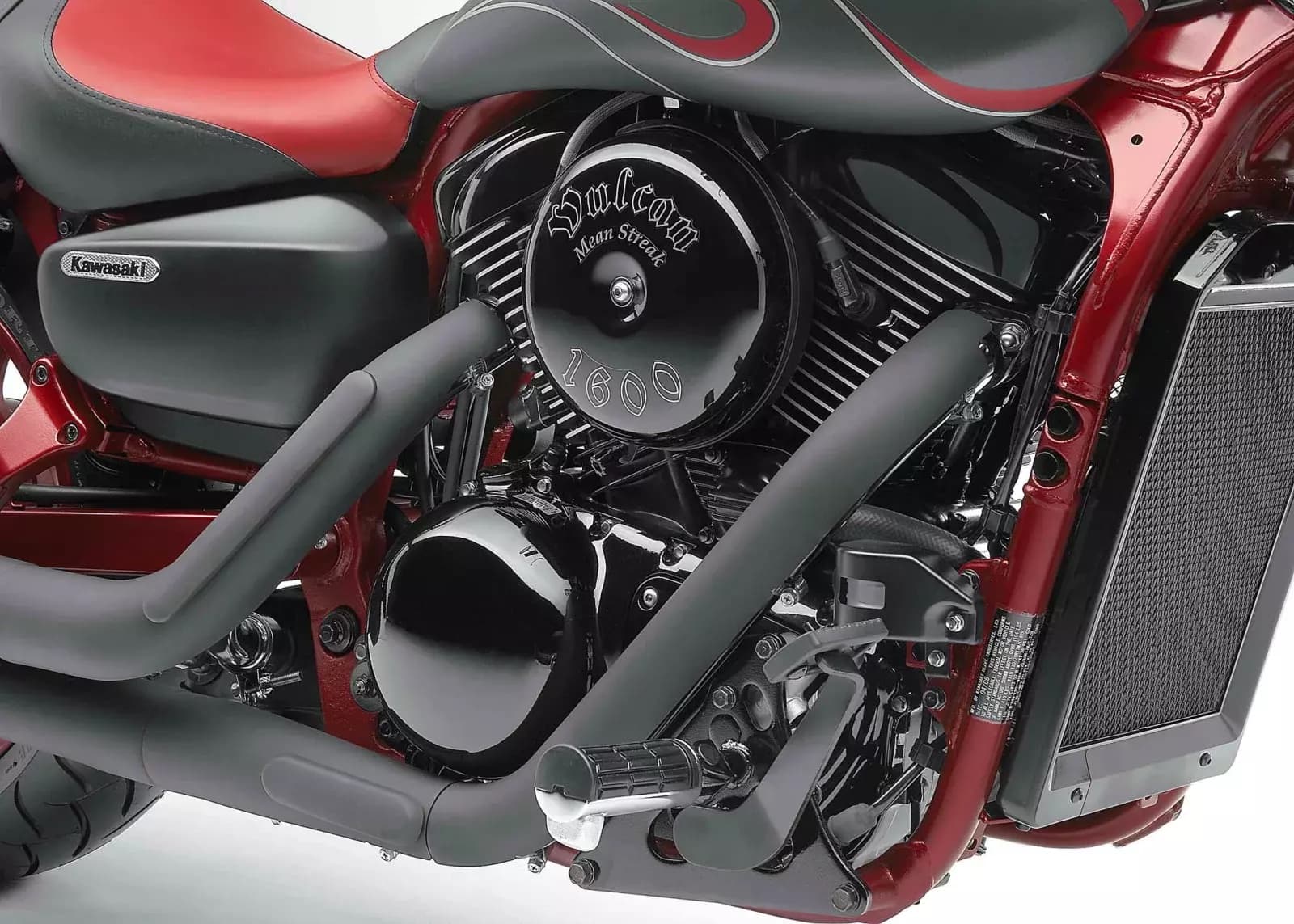
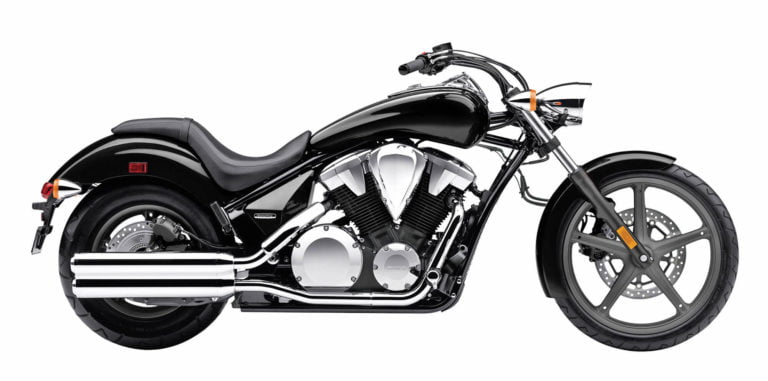


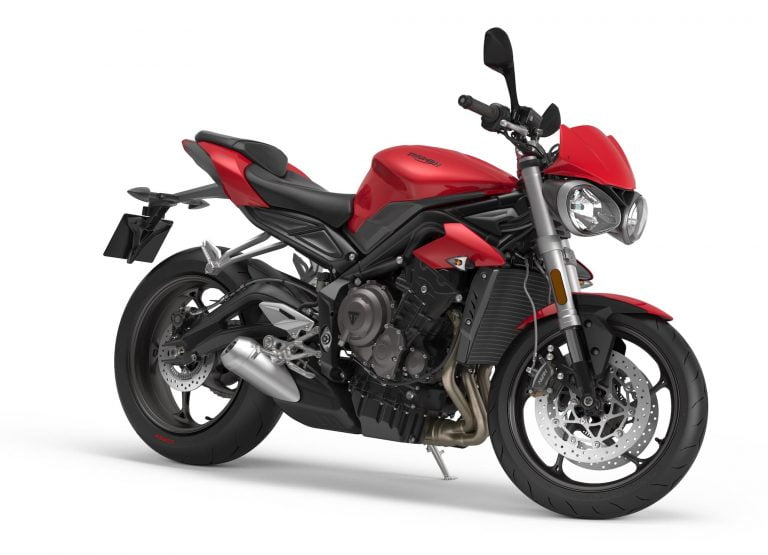
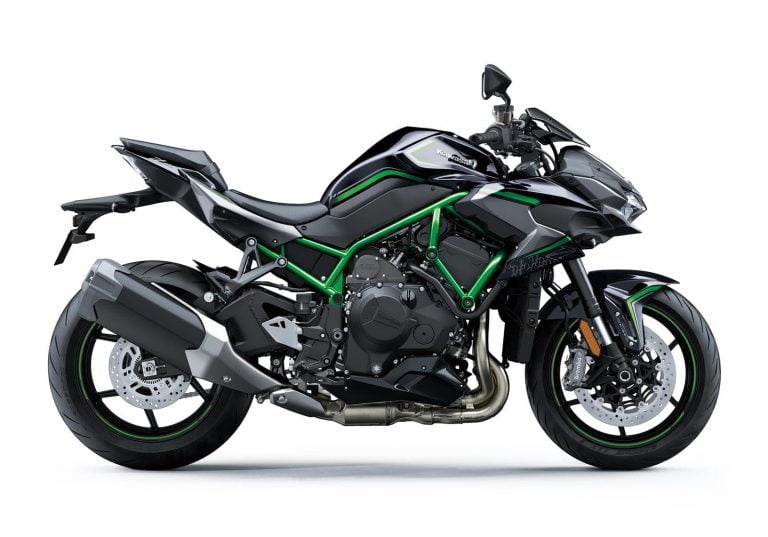
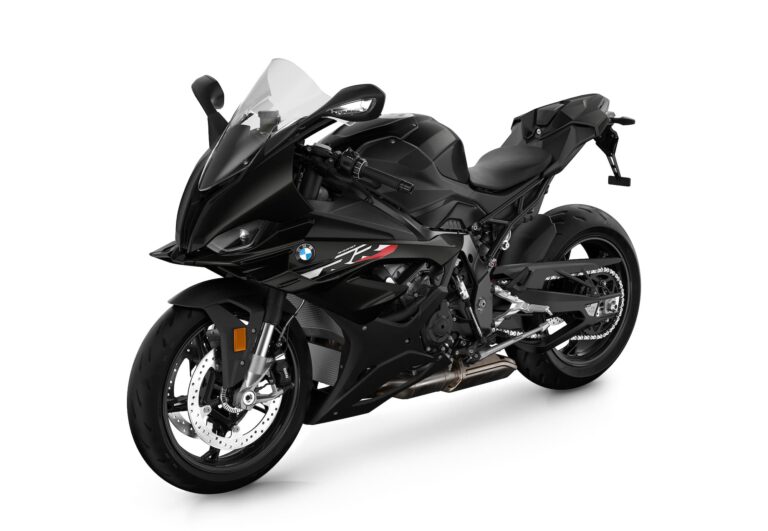
Actually I’m impressed. The material in this article is accurate, concise and informative, not even comparable to the usual trash you find on the internet these days. Everything here is consistent with the official service manual. Keep up the good work 🙂
Thanks my friend! I write it all as if it were for my own bike. Cracker of a bike by the way, I’ve looked at them for a while…